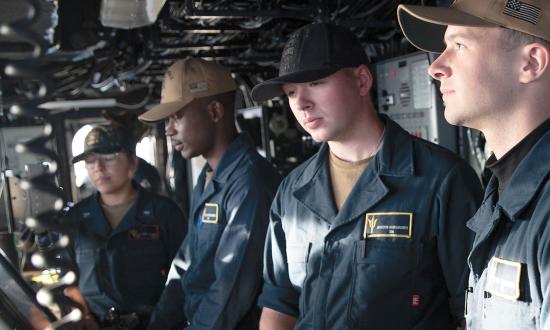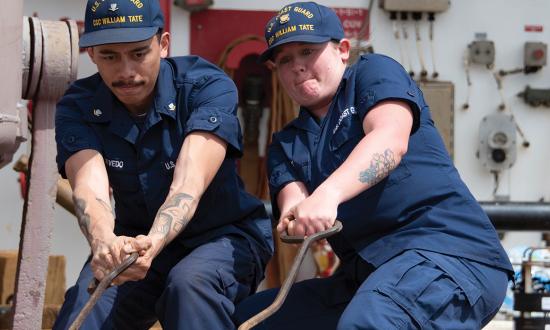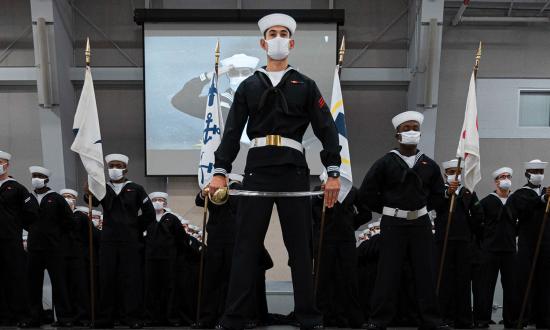Navy tradition emphasizes the value of working up through the ranks, and with rank follows the immense responsibility of caring for individuals below you—and accountability for both their actions and your own. This dedication is recognized and rewarded in tangible ways, such as bigger racks, the chiefs’ mess, and—of course—pay increases for junior sailors. The Navy ostensibly cares about its enlisted sailors. Yet in 2008, the Military Leadership Diversity Commission found that less than 30 percent of enlisted men who served from 17 months to 6 years decided to reenlist, with that number dropping another 10 percent for women.1 Something must change. The welfare and development of enlisted sailors must be a larger priority for Navy leaders.
A Stronger Navy
My senior chief always reminds sailors that “this is a warship, not a cruise ship.” This is true. Nothing matters more than the mission. It takes a team to carry out a mission properly and effectively, and sailors must keep their heads in the game to thrive under trying conditions. This often results in stressful environments—and stress has consequences. In the United States alone, the Harvard Business Review noted that 80 percent of workplace accidents are attributed to stress. In the Navy, any accident could be fatal.2 Some ships severely restrict the use of cellphones, and certain ratings are undermanned to the point that sailors lack the down time to get on a computer and reach out to their loved ones on land. The systems in place for enlisted personnel to reach out for help are well-intentioned but are limited and often too public when a sailor needs serious help.
As good as the intentions of those conducting Navy-wide decisions may be, they are worth nothing without true and honest care for the enlisted members’ concerns, program preservation, and upscaling these programs if necessary to cover all crew members.
Limited Mental Health Resources
The more undermanned a rating, the more hours that must be covered by a repeating loop of sailors, resulting in hours of lost sleep and a serious effect on sailors’ mental health. Suicides have seen an uptick since 2018 from 20.7 to 21.5 suicides per 100,000 service members in 2019. USNI News notes that, “On larger ships, the teams include medical personnel, and the teams also include a civilian resiliency counselor that deploys with the ship to serve as a licensed clinical health provider.”3
What the article fails to mention is that a larger ship, such as an aircraft carrier, deploys with more than 4,000 sailors. How can a single licensed clinical mental health care expert provide for a crew of that size? How can it be possible to strengthen the naval profession if those serving feel discouraged to the point of declining a second contract and those currently serving and in desperate need of help remain unheard?
I am a sailor on board the USS Gerald R. Ford (CVN-78). Our ship’s laundry does not have enough washers and dryers and they are often broken. We also share a berthing with our first class and leading petty officers. I do not believe this is professional, and it diminishes levels of respect to see your leaders undressed. Sailors lack resources to contact home, basic necessities routinely run out, and parts to repair essential equipment take months to arrive.
The Navy claims to promote a culture of excellence, but it must focus on the crews. I am proud to serve, and I am proud of how the Navy recruits people from all walks of life, brings them together, and promotes taking care of one another rather than yourself. I believe it is possible for the outside to match the inside, but it starts with those making the decisions for enlisted sailors and whether they listen to the small voices such as my own.
1. Department of Defense Office of Diversity Management and Equal Opportunity, “Reenlistment Rates Across the Services by Gender and Race/Ethnicity,” Military Leadership Diversity Commission Issue Paper no. 3, Homeland Security Digital Library, April 2010.
2. Emma Seppälä and Kim Cameron, “Proof That Positive Cultures Are More Productive,” Harvard Business Review, 1 December 2015.
3. Sam LaGrone and Megan Eckstein, “Pentagon ‘Very Concerned’ With Military Suicide Trends; Effect of Pandemic on 2020 Rates Unclear,” USNI News, 1 October 2020.








